Job sites with nice looking ponds and water features are a gift to lighting. The types of fixtures needed are few, but you generally need several (or many) of them to accomplish “the look.”
This type of lighting can be divided into two basic categories: vertical and horizontal. Some of the very best pond lighting doesn’t really use underwater fixtures at all, but rather uses the horizontal surface of the water for its ability to reflect illuminated scenes. We call this “mirror” lighting; the smoother the water, the better the reflection.
In contrast, the lighting of vertical water surfaces like water falls, basalt columns, fountains, etc. can be up lit and be very eye catching as well. Physiologically the human eye sees vertical surfaces first, then the horizontal plane, so that makes vertical water stand out more. By introducing light into the most turbulent water, you create more sparkle because the bubbles catch the light.
Submersible Fixtures (integrated and drop-in LED)
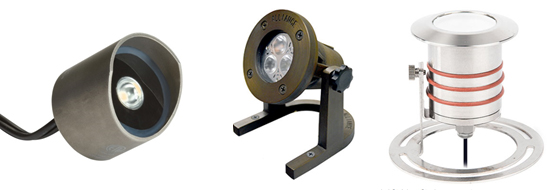
Accent Lights & Adjustable In-Grade Fixtures (integrated and drop-in LED)
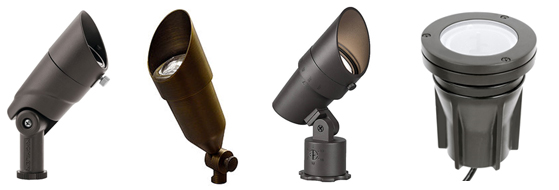
In addition to “projection” fixtures above that emit a beam of light, there are also submersible fixtures that sit on the bottom of a shallow pond and emit light in all directions. Because of the maintenance required to keep these types of fixtures clean (free of algae, etc.) they have become less popular over the years. Additionally, it’s always a good idea to provide a protected and dark area for fish (especially koi) to get away from the light and any predators that might be lurking about at night.
Another added benefit with LEDs is that they typically run cooler than incandescent fixtures, so they don’t add a lot of heat into the water. This can help minimize certain types of algae growth and it’s generally better for animals living in the pond to not heat the water. While there are always exceptions to every rule, generally a Kelvin Temperature of 3000 to 5000 looks best in water because it’s a crisper, whiter light bordering on a slight bluish tint, and that tends to give clear, clean water a fresher look.
Mirror Lighting
As long as you have a body of water and some sort of vertical element on the opposite side to light, you can create a stunning reflection on the water. IT doesn’t matter what vantage point you choose. It may be a view from a patio, inside the house, from the road, etc. Depending on the size of what you’re illuminating, you will likely need multiple in-grade or accent fixtures.
One key thing to remember is that you’ll want every fixture to have a cowl or be placed behind plant material or stones, etc. so that you don’t see the light sources. Seeing the tiny point(s) of brightness detracts from the scene. The closer the illuminated area is to the edge of the water feature the better it tends to show up on the water’s surface, but that can be affected by brightness levels, height of the lit objects, etc.
Please note that the darker (unlit) the body of water is, the better the reflection. If you install lighting in the water (pond or pool), there’s just not enough contrast. The reflection will not show up well. You also need to be careful with placement of path lights, and any down lights that are facing or close to the water’s edge. The direct reflection of a lamp, rather than an illuminated object, on the surface of the water can cause very harsh glare and ruin the view.
Illuminating Water Falls
Sometimes the lighting design calls for just the water feature only to be illuminated, while other times the water element is just one part of the total scene. There is no rule stating that you have to include a water feature in the lighting plan. If it doesn’t fit into the plan and it’s not a key element, then don’t light it.
Maintenance is always an important factor and submersible fixtures can be a challenge. Make sure you leave sufficient wire that will allow for fixtures to be pulled out of the water for any sort of repair/replace, etc. General cleaning (removing algae, etc.) can be done in place, but will depend on the depth of the water feature.
Fixtures can be placed in front of the falls, directly under them or even behind them to create different looks. Some water falls are very smooth while others are quite rough. How you choose to illuminate them can differ from feature to feature. The key is make sure that the fixtures have a heavily weighted base. Or, they can be surrounded by stones, or tucked into a niche to keep them in place. These will help you maintain your original design intent.
The best time to place fixtures in a water feature is at night. This way you can see what it actually looks like. It does help to have a knowledgeable “spotter” to tell you what needs moved. If your client is engaged and excited about that part of the plan, ask them to get involved. Even if you position them during the day, you should come back and see how it looks at night. This way you can verify that reality looks like the plan you envisioned in your head.
Placement of a fixture(s) is important. Light can refract if under the water, or reflect off the surface. Sometimes experimenting with different fixtures and various placements is needed to figure out the best options. A great technical reference for learning more about lighting various types of water features is The Landscape Lighting Book, Third Edition, by Janet Lennox Moyer (Wiley, ISBN 978-1-118-07382-7).
Illuminating Basalt Stone Columns
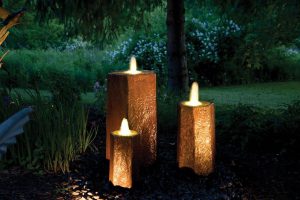 Lighting basalt columns requires one to three fixtures per column around the perimeter of each column (depending on how many sides need to be lit), and a waterproof fixture inside the column.
Lighting basalt columns requires one to three fixtures per column around the perimeter of each column (depending on how many sides need to be lit), and a waterproof fixture inside the column.
This can be fiber optic, LED “Light Ring” fixtures or special LED fixtures threaded into the plumbing itself. Water will “carry” the light for a certain distance. This creates a pleasing glow as it exits the stone column.
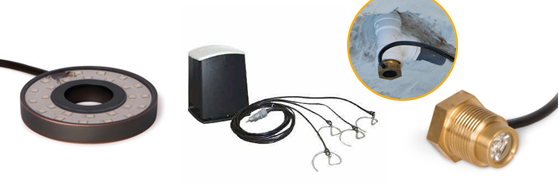
Fountain Lighting
A number of fountains and aerators offer lighting kits that will easily mount to the base allowing easy illumination of the water sprays. Colored lighting options (solid color) and color changing (“RGB” – Red Green Blue) are also available. Some manufacturers offer a wide range of products from programmable RGB lights that can tie into a music source all the way to a more generic fixture that can be retro-fitted to any fountain. So if your unlit fountain isn’t producing the “WOW” factor you want, punch it up with some light to make it a true focal point.
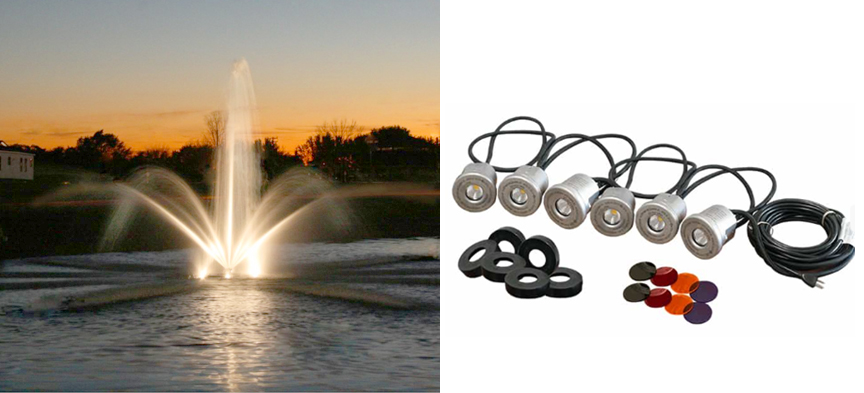
Note: The National Electrical Code (NEC) disallows low voltage fixtures in bodies of water meant for a human occupation. This includes spas, swimming pools etc. Special fixtures that are 120V, directly grounded and built for the purpose are required for these types of installations. A qualified electrical contractor should install all 120V fixtures.



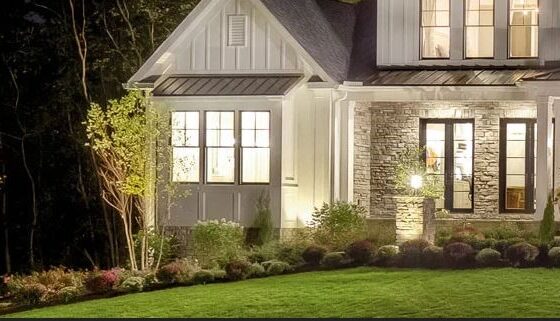



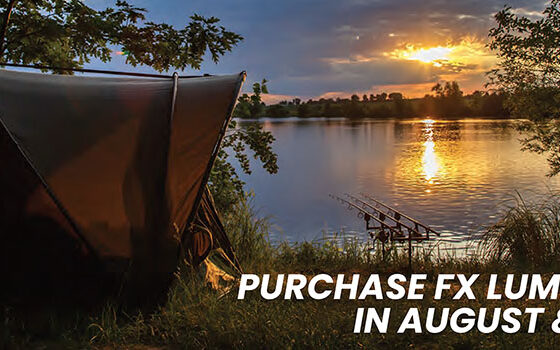





It sure was nice to know that there are water fountain lightings that can easily be mounted so that the water sprays are illuminated. If that is the case, then I will be sure to look for one as soon as possible since my parents will be installing a water fountain in the garden very soon. Of course, I will get one that matches the fountain to make the most out of the appearance. Hopefully, I can get one as soon as possible.